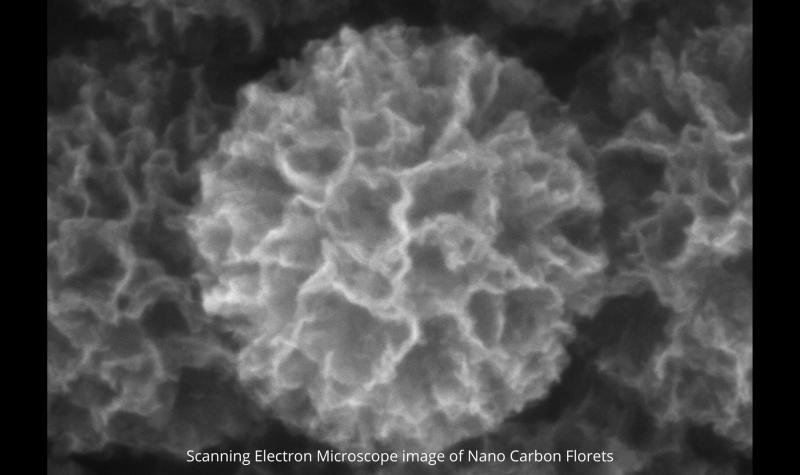
Researchers design a new material for removing heavy metal contaminants from water in a single step.
Nanomaterials are revolutionising the way we do things with applications in medicine, electronics and biocompatible materials, to name a few. Scientists are studying various nanoforms of carbon—nanotubes, nanocones, nanohorns, two-dimensional graphene and even carbon onions! Now, researchers from the Indian Institute of Technology Bombay have added a new form to this list called nano carbon florets. These nano-sized florets, shaped like marigold flowers, have much more than just good looks to flaunt; they can help keep the environment clean by removing harmful heavy metal pollutants from industrial effluents.
In a study published in the journal ACS Applied Nano Materials, Prof C Subramaniam and his team from the Department of Chemistry have designed nanocarbon florets that can remove up to 90% of pollutants containing arsenic, chromium, cadmium and mercury. These florets also work in contaminated water with a wide range of acidity or alkalinity. They remove impurities by adsorption—impurities stick to the surface of the florets as the water passes over it. All it takes is a wash with a mild acid, and they are as good as new! The nanocarbon florets are chemically and mechanically robust and stay stable over a wide temperature range. Hence, they are a convenient and sustainable solution to decontaminate water.
Effluents from chemical industries, tanneries or chrome plating plants contain ions of hazardous heavy metals such as arsenic, chromium, mercury and cadmium. These substances can cause cancer and genetic mutations. They tend to accumulate over time in the surroundings, inflicting long term harm to the environment.
Adsorption-based filtering is easy to implement and scale, and the filter material can be reused. It is also the most advantageous and economical method as compared to conventional methods like chemical precipitation, ion exchange, electrochemical removal and membrane separation. Methods that use membrane-based separation remove water from impurities whereas adsorption removes impurities from water. Hence, it is also more energy-efficient and wastes less water.
An ideal filter that works on adsorption needs to have a high surface area so that more impurities can stick to it.
“Just having more surface area is not enough, but having accessible surface area is the key parameter,” explains Prof Subramaniam.
The filter material must be porous, with a pore size suitable for the impurity to pass through, and should have enough pore density. It should allow impurities dissolved in water to interact and should be chemically and mechanically stable.
Adsorbents explored so far do not satisfy all the parameters. For example, synthetic compounds can efficiently and selectively remove specific impurities but are not biocompatible and hence are difficult to dispose of. On the other hand, biomass-based materials are inefficient and cannot be reused. The emerging metal-organic frameworks, although efficient, are unstable. Carbon-based nanomaterials score better than others, but many of them are hydrophobic, so water takes time to interact with these. Carbon-based nanomaterials such as nanotubes and nanohorns tend to lump together, reducing the surface area and further slowing adsorption. The researchers of this study tried to address these shortcomings by designing a hydrophilic nanocarbon material that attracts water.
In the current study, the researchers created nanocarbon florets using chemical vapour deposition of carbon on a silica-based template. The florets are formed of lamellar, feather-like graphitic sheets that converge at the centre and are held in place through a solid, connected core, much like a marigold flower. These florets offered a large accessible area for adsorption, were hydrophilic and chemically stable in highly acidic or alkaline water. They can also filter various impurities, thus eliminating the need for using different filter material for each contaminant.
The researchers tested the efficiency of their florets by passing water contaminated with arsenic, chromium, cadmium and mercury. Though these florets tended to prefer arsenic and chromium, they removed 80-90% of all impurities. The researchers observed that the efficiency of adsorption was more when a single contaminant was present instead of multiple pollutants. The filtering ability of these florets reduced only slightly even after repeated use.
“Other chemically-tailored adsorbents such as zeolites, activated carbon, nanotubes, graphene, polymers are most effective against a single metal ion, with both efficiency and capacity substantially reducing for other ions,” say the researchers.
Though the chemical properties of nanocarbon florets aid adsorption, the engineered structure contributes significantly to the higher value of adsorption.
The researchers have filed a patent for their design and are looking at commercialising the filter.
“More work in partnership with industry will be needed to use these nanocarbon floret filters at an industrial scale,” concludes Prof Subramaniam.
This article has been run past the researchers, whose work is covered, to ensure accuracy.






